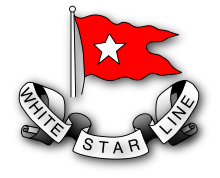SS Celtic (1872)
 White Star Line logo and house flag | |
| History | |
|---|---|
| Name: | SS Celtic |
| Owner: | White Star Line |
| Route: | Liverpool - Queenstown (Cobh) - New York City |
| Builder: |
|
| Yard number: | 79 |
| Laid down: | as Arctic |
| Launched: | 18 June 1872 |
| Completed: | 17 October 1872 |
| Maiden voyage: | 24 October 1872 |
| Fate: | Sold to the Thingvalla Line of Copenhagen on 6 April 1893 |
| Name: | SS Amerika |
| Owner: | Thingvalla Line of Copenhagen |
| Route: | Copenhagen - Christiania (Oslo) - Christiansand - New York City |
| Acquired: | 6 April 1893 |
| In service: | 27 May 1893 |
| Out of service: | September 1897 |
| Fate: | Scrapped at Brest in 1898 |
| General characteristics | |
| Class and type: | Oceanic-class ocean liner |
| Tonnage: | 3,867 gross tons |
| Length: | 437.2 ft (133.3 m) |
| Beam: | 40.9 ft (12.5 m) |
| Installed power: | Steam |
| Propulsion: | Single screw |
| Sail plan: | Four masts (rigged for sail) |
| Speed: | 14 kn (26 km/h; 16 mph) |
| Capacity: | 166 1st- and 1,000 3rd-class passengers |
| Notes: | Iron construction, single funnel |
SS Celtic was a steamship built for the White Star Line by shipbuilders Harland and Wolff of Belfast.
The Celtic (later the Amerika), the first of two White Star ships to bear the name, was the second of two Oceanic-class liners commissioned by White Star, following the success of their first four steamships (the Adriatic being the earlier of the new pair). The new ship was originally supposed to be named the Arctic, but since the American Collins Line had had a paddle-wheel steamer with that name which had sunk in 1854, the White Star management changed their minds, and settled on the name Celtic.
In 1880, Edward Smith, who later became the Line's most celebrated Captain, and the Captain of Titanic, joined the crew of Celtic as her Fourth Officer.
On 19 May 1887, at about 5:25 in the afternoon, the Celtic collided with the White Star liner Britannic in thick fog about 350 miles (560 km) east of Sandy Hook, New Jersey. The Celtic, with 870 passengers, had been steaming westbound for New York City, while the Britannic, carrying 450 passengers, was on the second day of her eastward journey to Liverpool. The two ships collided at almost right angles, with the Celtic burying her prow 10 feet (3 m) in the aft port side of Britannic. The Celtic rebounded and hit two more times, before sliding past behind Britannic.
Six steerage passengers were killed outright on board Britannic, and another six were later found to be missing, having been washed overboard. There were no deaths on board Celtic. Both ships were badly damaged, but Britannic more so, having a large hole below her waterline. Fearing that she would founder, the passengers on board began to panic and rushed the lifeboats. Britannic's captain, pistol in hand, was able to restore some semblance of order, and the boats were filled with women and children, although a few men forced their way on board. After the lifeboats had launched, it was realized that Britannic would be able to stay afloat, and the lifeboats within hailing distance were recalled. The rest made their way over to the Celtic. The two ships remained together through the night, and the next morning were joined by the Wilson Line's Marengo and the British Queen of the Inman Line, and the four slowly made their way into New York Harbor.
The Celtic was sold in 1893 to the Thingvalla Line. In 1898, the year that Thingvalla was absorbed into the Scandinavian American Line, the Amerika was scrapped.
Sources and references
- reprint of an article from Illustrated London News, May 28, 1887 of the collision
- Info from The Ships List
- Thingvalla info
- E. Smith info source